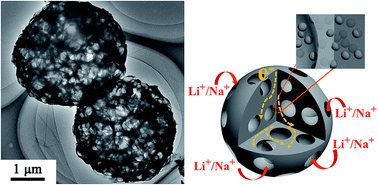Ultrasmall Sn nanodots embedded inside N-doped carbon microcages as high-performance lithium and sodium ion battery anodes†
Abstract
Sn based materials are promising anodes both in Li-ion batteries and Na-ion batteries due to their high theoretical capacities (994 mA h g−1 for LIBs and 847 mA h g−1 for SIBs, respectively). In order to improve the cycle performance, Sn/N-doped carbon microcage composites (Sn/NMCs) with Sn nanodots uniformly embedded inside the N-doped carbon microcages are synthesized through a simple spray drying process, followed by thermal treatment. When used as electrodes, Sn/NMCs exhibit an initial reversible capacity of 780 mA h g−1 at 200 mA g−1, and maintain 472 mA h g−1 after 500 cycles in LIBs. For Na-ion batteries, Sn/NMCs deliver an initial reversible capacity of 439 mA h g−1 at 50 mA g−1 and maintain 332 mA h g−1 after 300 cycles. The remarkable electrochemical performance is mainly owing to the advanced structure of Sn/NMCs, which could be attributed to the pore-formation using NaCl, and the grain size inhibition of Sn using N-doped carbon. Moreover, this preparation method is accessible to scale up and can be extended to fabricate other electrode materials.



 Please wait while we load your content...
Please wait while we load your content...